It is no question that spiders are among the scariest animals in the world. Spiders send a chill down most people’s spines, with their long wiry legs and fangs. Some can be as small as an ant, while others are large enough to cover your face! Almost all spiders are venomous, but that does not mean they are dangerous to humans. There are more than 50,000 species of spiders in the world, but only a select few pose a risk to people. There are countless types of arachnids to discover around the globe. Let’s take a look at 10 terrifying spiders found in Ireland, and what you should know about each one.
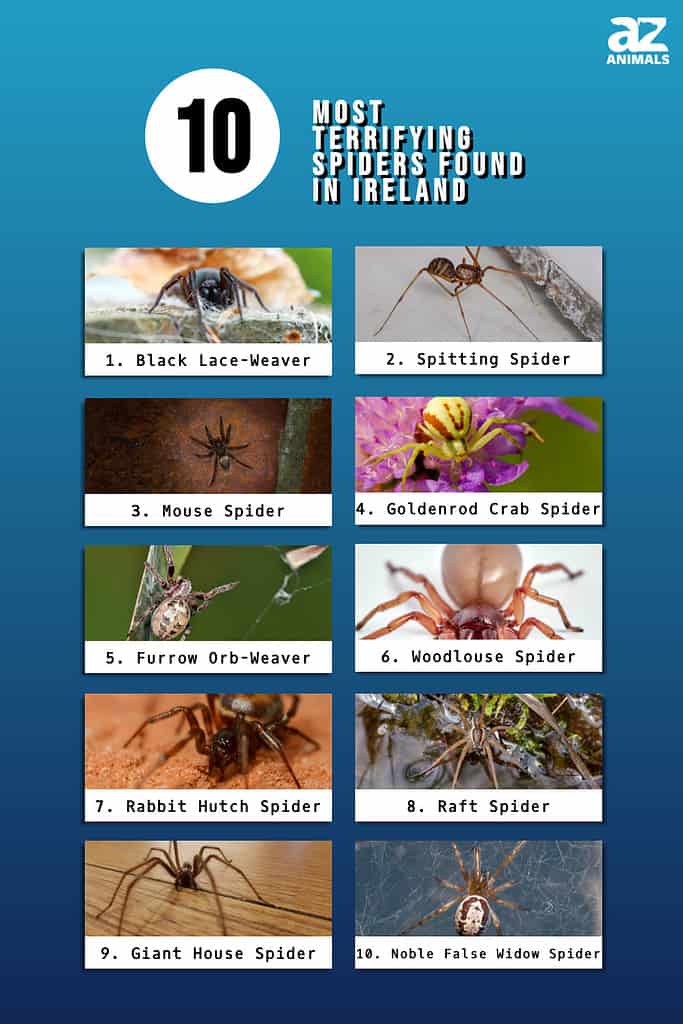
1. Black Lace-Weaver (Amaurobius ferox)

The black lace weaver is a native of Europe, found in Ireland, but also across North America and New Zealand.
©Wildsmith_Westwood/Shutterstock.com
The black lace weaver is a native of Europe, found in Ireland, but also across North America and New Zealand. This spider is nocturnal and lives in dark, secluded places. They are named after their wooly silk, which looks like lace. They build messy webs along walls, cellars, and fences, and also fashion a retreat to hide in.
The body of the black lace-weaver ranges from 0.31 to 0.62 inches when fully grown. They are dark black, tan, or reddish brown, and have small velvet-like hairs. Their abdomens are round, with ghoulish, cream markings.
This species has large fangs and an aggressive nature! They are often quick to bite. Reported symptoms of their venom include pain similar to that of a wasp sting and swelling. Their venom neutralizes small insects that pass over their sticky lace webs, but it is not dangerous to humans.
2. Spitting Spider (Scytodes thoracica)
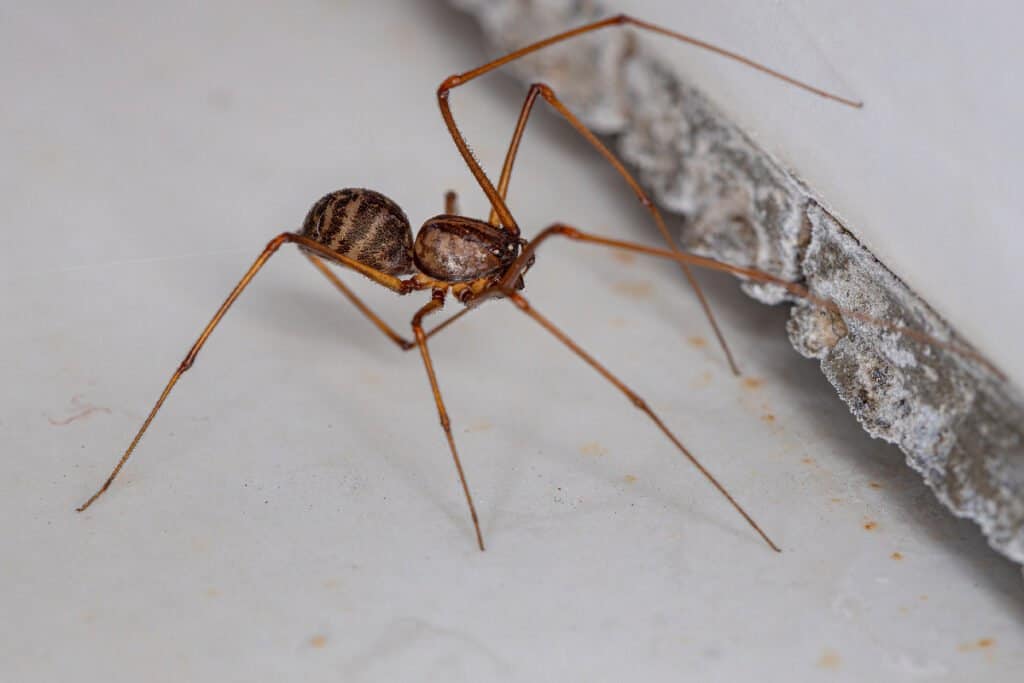
They are able to accurately spit a distance of 0.39 to 0.79 inches away from their target.
©iStock.com/ViniSouza128
Spitting spiders have an extensive range that stretches around the globe. They are unique, and as their name suggests, they have the ability to spit! Their spit is a mix of liquid silk and venom, which they use to paralyze and capture prey.
Spitting spiders are typically tan in color and may have dark markings. They have very round bodies, as well as a round cephalothorax. Their legs are thin, and nimble, with their front pair being the longest. Moving very slowly, spitting spiders use their two front legs to aim when they are about to spit.
These spiders are able to accurately spit a distance of 0.39 to 0.79 inches away from their target. They spit very quickly at an extreme speed of around 1/700th of a second. They emit a sticky substance in a zig-zag pattern, which entangles their prey and prepares them for consumption.
3. Mouse Spider (Scotophaeus blackwalli)
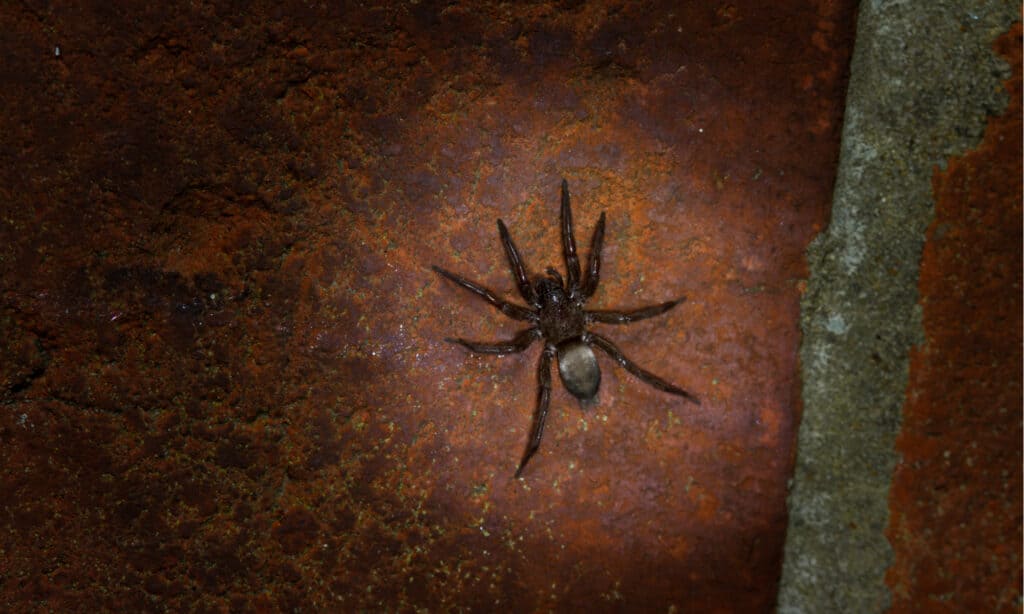
They grow small velvety hairs all over their body. These hairs look similar to the hairs on a mouse, hence its name.
©thatmacroguy/Shutterstock.com
Do not confuse this spider with the other species that holds the same name, the dangerous red-headed mouse spider that lives in Australia. Scotophaeus blackwalli are members of the ground spider Gnaphosidae family. They are native to Ireland and Europe in general. Additionally, they have been introduced to other regions of the world, like North America, Iran, and Turkey.
Mouse spiders have a body size between 0.35 to 0.47 inches. They have brown legs, with grayish or brown abdomens. They grow small velvety hairs all over their body. These hairs look similar to the hairs on a mouse, hence its name. This species is active at night and sometimes makes its way indoors while looking for food. Mouse spiders, like most of the spiders found in Ireland, are not dangerous.
4. Goldenrod Crab Spider (Misumena vatia)
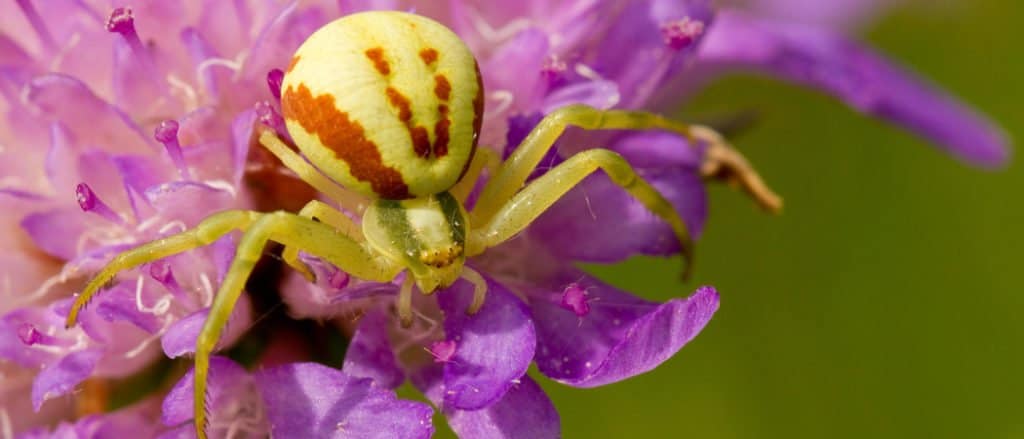
Their smaller size and pretty color make them less terrifying than other spiders found in Ireland, and they are harmless to humans.
©Radka Palenikova/Shutterstock.com
Goldenrod crab spiders are native to Europe but also inhabit North America. Like other crab spiders, this species is named after its crab-like appearance. Females are much larger than males and have a larger round abdomen. This species is either yellow or white and, like a chameleon, is able to change between the two colors. Color transformations occur very slowly, taking between a few days to a month.
The warm summer months are when this spider is active, and they are diurnal spiders. Goldenrod crab spiders live on flowers, like goldenrod, thistle, or daisies. Females sit on flowers, while males stay close, waiting for a chance to mate. Males are very territorial and guard their potential mates. After hatching, spiderlings use their silk to disperse, flying into the air using a method called ballooning.
This spider does not use webs to catch prey. Instead, it uses camouflage to hide and wait. These spiders grab unsuspecting prey with their crab-like claws, eating pollinators like bees and butterflies.
Goldenrod crab spiders have a body size between 5 to 10 mm. Their smaller size and pretty color make them less terrifying than other spiders found in Ireland, and they are harmless to humans.
5. Furrow Orb-Weaver (Larinioides cornutus)
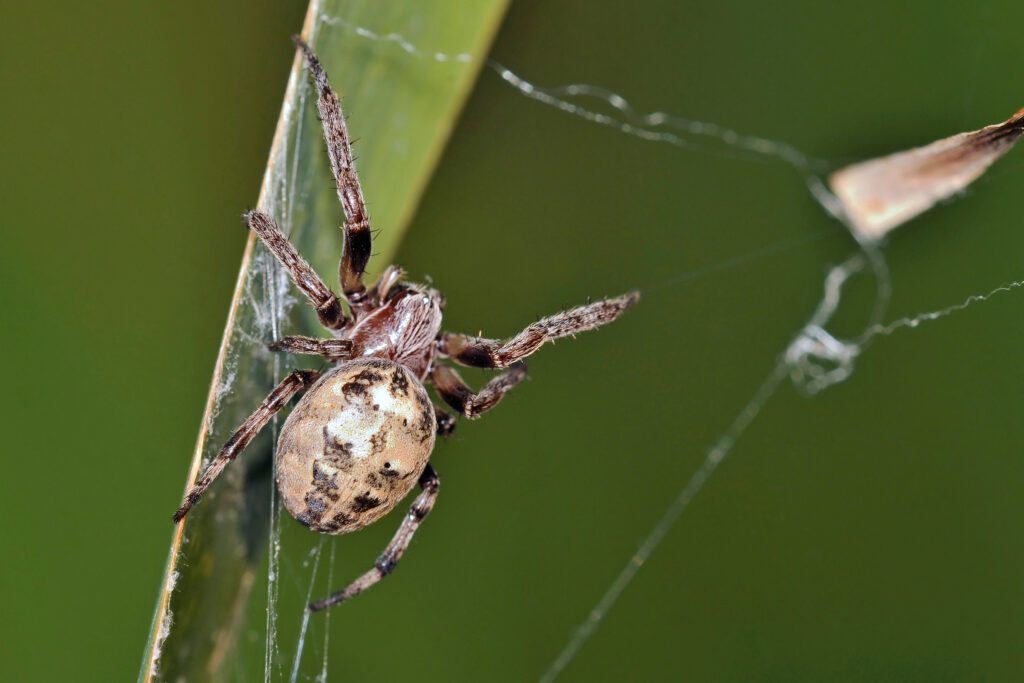
Furrow orb-weavers are common spiders to find in homes and on porches.
©ASakoulis/Shutterstock.com
There are more than 3,500 orb weaver species found around the globe. The furrow orb-weaver has a large global range. They prefer moist and vegetated habitats, and females create large circular webs to live in. This spider lives around water in the summer months, using low-lying vegetation to support its web.
Orbweavers are sexually dimorphic, and males are typically identifiable by their smaller abdomens. Males also have longer legs proportionally since they do not spin webs, and wander more often. Furrow orbweavers are tan and get their name from the marking that runs across their abdomen, which looks like a wavy furrow, or trench.
Furrow orb-weavers are common spiders found in homes and on porches. At night, their circular webs capture flying insects like gnats or moths. When prey sticks to their web, furrow orb-weavers ambush and neutralize the insects with their venom. Orb-weavers are not aggressive spiders, and their venom is weak. It is not dangerous to people unless an allergy is present.
6. Woodlouse Spider (Dysdera crocata)
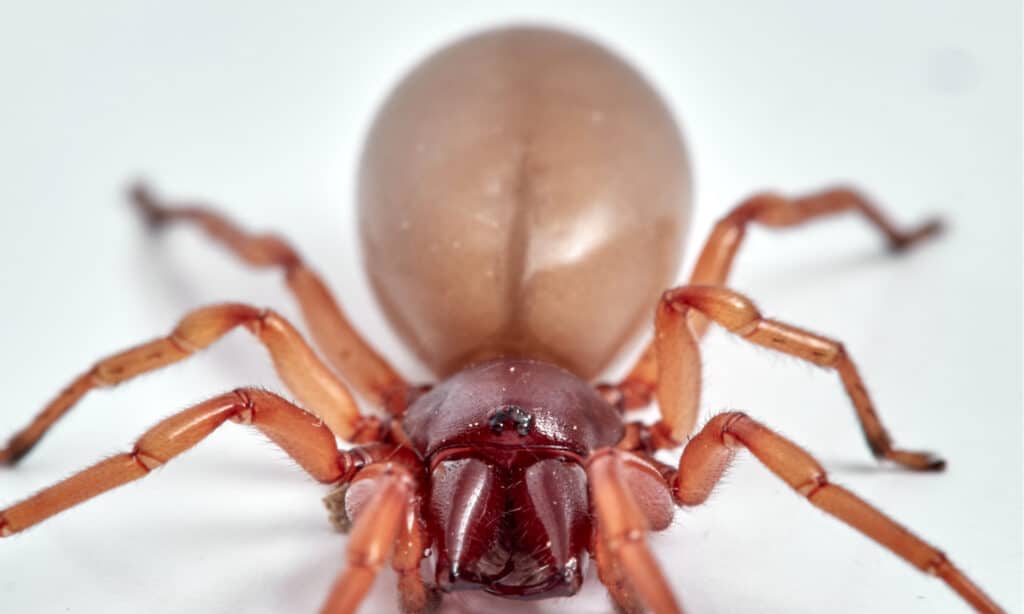
Because their large fangs are strong enough to pierce the exoskeleton of their prey, their bite can be painful.
©Macronatura.es/Shutterstock.com
Woodlouse spiders have a large global range and originated from the Mediterranean. This spider is active at night, and during the day, they create silk sacs to rest in. Woodlouse spiders are associated with woodlouse since both generally inhabit the same area. They have orange coloring, with a tan abdomen.
Woodlouse spiders live in dark and moist environments. As their name suggests, they feed on woodlouse, but also on other arthropods like roaches, centipedes, and other spiders. Because their large fangs are strong enough to pierce the exoskeleton of their prey, their bite can be painful. While their venom is not strong, you should clean the wound if bitten, since infections can occur.
7. Rabbit Hutch Spider (Steatoda bipunctata)
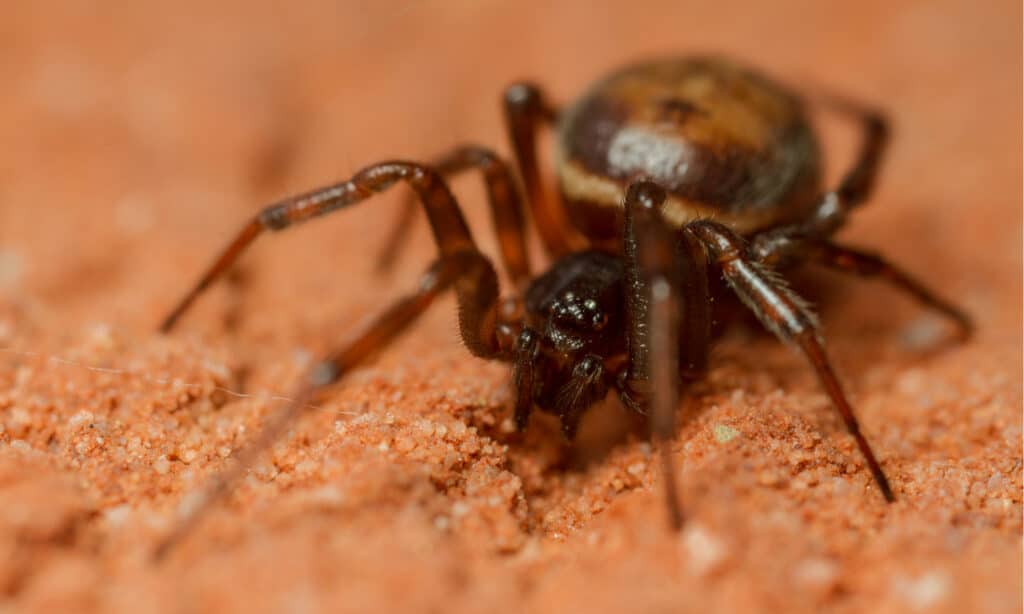
Rabbit hutch spiders have dark brown coloring, with a waxy appearance, and a cream stripe running down their abdomen.
©thatmacroguy/Shutterstock.com
The rabbit hutch spider is one of the few species that belong to the Steatoda genus that inhabits Ireland. Appropriately named, this species often lives in rabbit hutches and other animal pens. They are attracted to the insects that animals bring with them. These spiders build messy webs.
Rabbit hutch spiders have dark brown coloring, with a waxy appearance. They have a cream stripe running down their abdomen and small dimples on their back. Males are smaller than females.
While they look like black widows and belong to the same family, they are not dangerous to animals or humans. Like other spiders, they are actually beneficial since they reduce the number of pests and insects near them. They use their webs to catch animals like fleas, mosquitoes, and flies, and sometimes even bring the animals they coexist with more peace due to the reduced pests.
8. Raft Spider (Dolomedes fimbriatus)
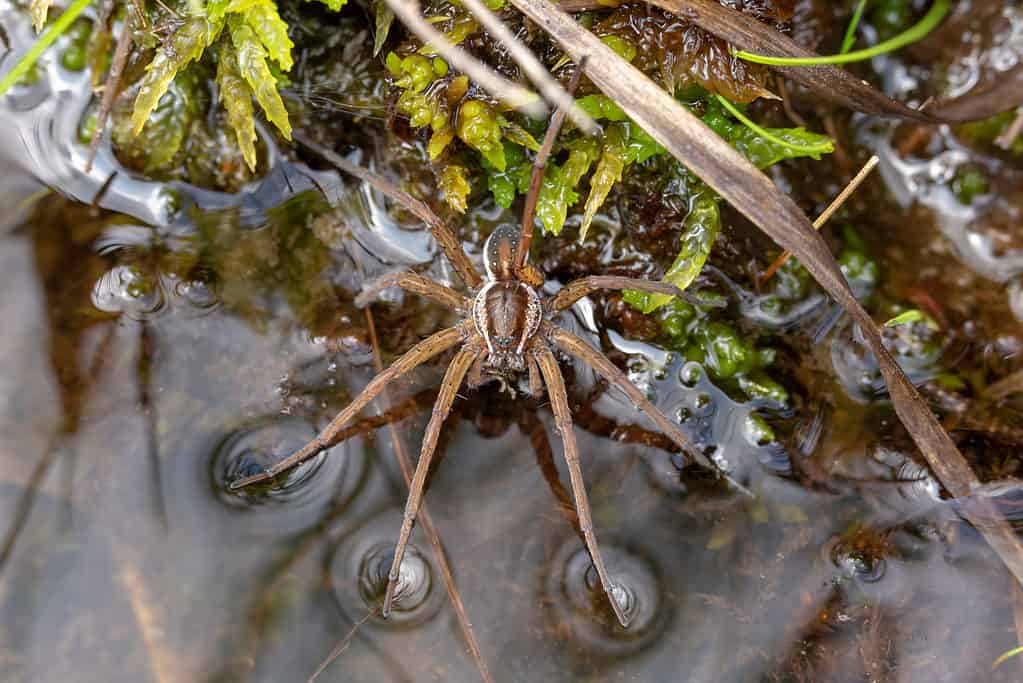
Like other fishing spiders, this species has good eyesight, with their eyes arranged in two rows of four.
©iStock.com/Jordon Sharp
Raft spiders are common in Ireland and other areas of Europe. They live near bogs and other water sources and have an impressive ability to skirt across the water’s surface. Raft spiders use their water-walking ability to hunt for small insects, tadpoles, and sometimes small fish. They are even capable of diving! And they grow hydrophobic hairs that keep them dry.
A fairly large spider, raft spiders typically have a body size ranging from 0.35 to 0.86 inches. An adult raft spider’s leg span can reach up to 2.7 inches. Tan in color, raft spiders have a white, cream, or yellow marking that runs down the sides of their body. White spots may appear on their abdomens. Like other fishing spiders, this species has good eyesight, with their eyes arranged in two rows of four.
Raft spiders are one of the most terrifying spiders in Ireland because of their size. In fact, they’re one of the biggest spiders in the country. However, they are harmless, and not seen often because of their nocturnal nature. This spider is most active during warmer months, and it is a wanderer, spending its time looking for prey. They are protective of their young. Mothers may sometimes carry a large egg sac in their mouths!
9. Giant House Spider (Eratigena atrica)

This spider is within the same genus as the hobo spider, and the two look very similar.
©iStock.com/George Inguanez
The giant house spider is a terrifying species, mainly feared because of its large size. Their leg spans are capable of reaching up to 1.8 inches, and on average, their body size is between 0.47 to 0.73 inches. Giant house spiders have a tan, reddish brown, or yellowish coloring. This spider is within the same genus as the hobo spider, and the two look very similar.
Giant house spiders live in homes, caves, and other structures, and build messy webs in secluded areas. They wait in their web, dragging invertebrates in when they get the opportunity. Additionally, their webs have a funnel built into a crevice for them to hide in. This species is capable of living up to six years. Seeing this spider is rare because they tend to stay in their webs.
10. Noble False Widow Spider (Steatoda nobilis)

The noble false widow spider is one terrifying spider, and it has the most potent venom of any spider in Ireland.
©JorgeOrtiz_1976/Shutterstock.com
The noble false widow spider is one terrifying spider, and it has the most potent venom of any spider in Ireland. Noble false widow spiders are native to the Madeira and Canary Islands, but this species has managed to expand its habitat around the globe. Bites from this spider may cause nausea, swelling, and fever, with symptoms lasting for around 12 hours.
Spiders within the Steatoda genus are called false widows, since they very closely resemble species within the Latrodectus widow spider genus. While both are members of the Theridiidae family, false widow spiders have much less potent venom than true widows.
Noble false widow spiders live both indoors and outdoors. They feed on small insects and woodlouse that stick to their webs. Since their eyesight is poor, they use vibrations to sense when things get near.
Summary of the 10 Most Terrifying Spiders in Ireland
| Spider | Scientific Name | Traits | |
|---|---|---|---|
| 1 | Black Lace-Weaver | (Amaurobius ferox) | Large fangs, aggressive nature; bite causes pain like wasp sting and swelling |
| 2 | Spitting Spider | (Scytodes thoracica) | Able to spit web and venom at a distance of 0.39 to 0.79 inches to paralyze and capture prey |
| 3 | Mouse Spider | (Scotophaeus blackwalli) | Body covered in velvety black hair similar to mouse hair |
| 4 | Goldenrod Crab Spider | (Misumena vatia) | Crab-like appearance; captures prey with claws rather than webs; can change between two colors |
| 5 | Furrow Orb-Weaver | (Larinioides cornutus) | Non-aggressive spiders with weak venom; prefer moist, vegetated habitats |
| 6 | Woodlouse Spider | (Dysdera crocata) | Feed on woodlouses, roaches, centipedes, and other spiders; large fangs can cause painful bite and infection |
| 7 | Rabbit Hutch Spider | (Steatoda bipunctata) | Pest reducer; inhabits rabbit hutches; looks like a black widow |
| 8 | Raft Spider | (Dolomedes fimbriatus) | Can float on water; Large body size from 0.35 to 0.86 inches and leg span up to 2.7 inches |
| 9 | Giant House Spider | (Eratigena atrica) | Massive size with leg spans up to 1.8 inches, and body size from 0.47 to 0.73 inches |
| 10 | Noble False Widow Spider | (Steatoda nobilis) | Most potent venom of all spiders in Ireland; Bites may cause nausea, swelling, and fever for up to 12 hours |
The photo featured at the top of this post is © IanRedding/Shutterstock.com
Thank you for reading! Have some feedback for us? Contact the AZ Animals editorial team.






